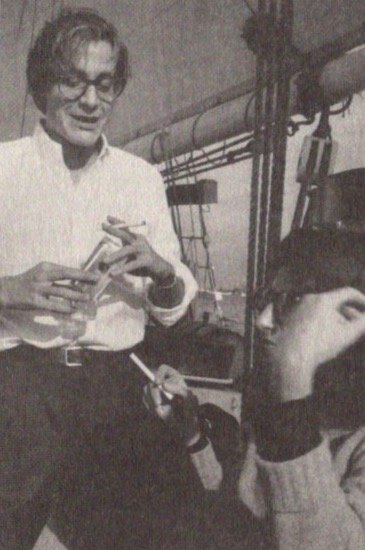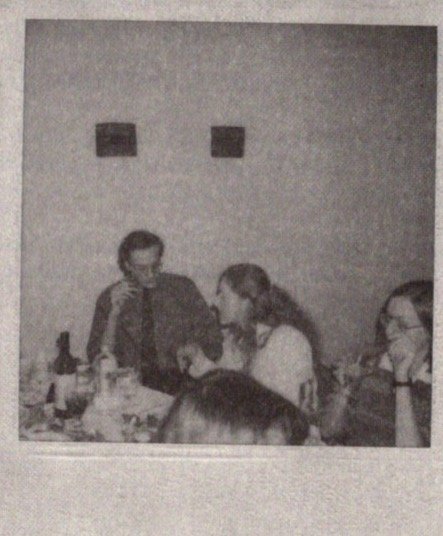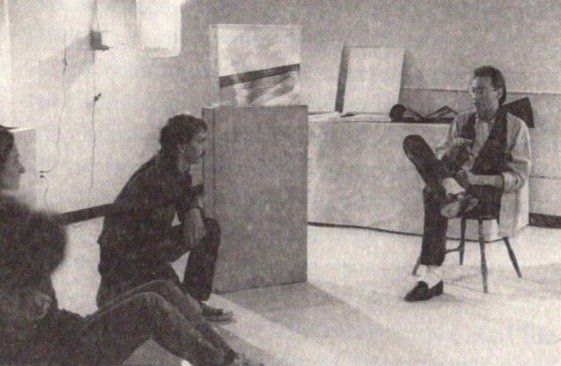CRAIG OWENS: WHY CULTURAL PRODUCTION?
“There remains art as production, as production”
Good models of art criticism (not art writing) are hard to come by these “vile days”, the words Gary Indiana used to describe his few years as an art critic for the Village Voice in the mid-1980s —something I’m not sure if he regrets or celebrates in his commentary after the fact.
The models I chose early on were ones that didn’t treat art as an autonomous art object separate from its context, but focused on the “frame” of art, what psychoanalysts Jean Laplanche and Jean-Bertrand Pontalis state as the setting: “the fantasy is not the object of desire, but its setting”. One such critical model that afforded the frame or setting its due vigilance was by Craig Owens.
“Who is free to define, manipulate and, ultimately, to benefit from the codes and conventions of cultural production? These questions shift attention away from the work and its producer and onto its frame— The work with which I find myself in most sympathy is the kind that is involved in an analysis of its own relationship to the institutions it relies on. And the terms by which it’s presented.”
For some time now I have put off writing on Craig Owens, because I wanted to keep him to myself. But in recent years he has gained a second wave of attention in the States and here in Europe.
In America in 2018, Paul Chan of Badlands Unlimited transcribed, edited and published a videotaped interview with the critic from 1984, conducted by feminists Lyn Blumenthal and Kate Horsfield. On the book’s cover Craig Owens is portrayed tall and vampiric in a Quaker College photograph, which he attended as a young man, one of the rare instances when Owens was caught on camera, like Vlad in the mirror before he became Dracula. The book title Portrait of a Young Critic, not only represents Craig Owens’ premature death by AIDS at 39, but the forever young fate of a brilliant generation of American artists at the turn of the 1980s.
In Europe in 2021, a limited dual-edition (Eng/German translation) of Craig Owens’ essay From Work to Frame, or, Is There Life After ‘The Death of the Author’? was published and launched during the pandemic at saxpublishers / FELIX GAUDLITZ, Vienna, as part of their essay serial (S*I*G), which works under this statement: “S*I*G is dedicated to the periodic presentation of singular essays. Manifest in printed form, it is light enough to not be inhibited by an institutional parent, while pitching a format for exchange of thought.”
It was wonderful to witness Craig Owens (and art criticism) being recognised in this way, three decades after his death. And yet I’m still not sure what it is about Craig Owens’ art criticism that influenced mine when I first started reading him over a decade ago. Maybe it was a passage like this:
“I feel it’s time to abandon this battle on behalf of art or culture. We have to begin to investigate the status of art and culture and the political and economic interests that it serves. That’s certainly a change in criticism. There is a tendency that we inherited from Clement Greenberg that characterises art as an endangered species. This seems to me to be so blind and so contrary to the facts, to this extraordinary proliferation of cultural activity. We ought to ask the real questions about why capitalism promotes this and what it gains from it, and how its interests are vested in it.”
It was also the way Craig Owens channelled contemporary artists’ voices in his essays, an artist’s voice we don’t hear so much these vile days, probably because of what Robert Smithson wrote in the mid-1970s in Artforum, words which Craig Owens would use to his own critical ends:
“Cultural confinement takes place when a curator imposes his own limits on an art exhibition, rather than asking an artist to set his limits [...] Some artists imagine they’ve got a hold on this apparatus, which in fact has got a hold of them. As a result, they end up supporting a cultural prison that is out of their control [...] Museums, like asylums and jails, have wards and cells in other words, neutral rooms called ‘galleries.’ [...] Works of art seen in such spaces seem to be going through a kind of esthetic convalescence.”
ROSALIND KRAUSS
Craig Owens emerged first as a student of the critic and editor of October Magazine, Rosalind Krauss, after a stint in what he described as the “Off-Off Broadway” theatre. His first mentor, Krauss became forever infamous in the artworld after she split-off from Artforum Magazine after artist Lynda Benglis’s celebrated dildo spread from 1974 was given a fully erect thumbs up by the magazine’s co-editors. Personally, I have grown to reject and regard the consensus around Benglis and the demonisation of Krauss and her so-perceived uppity October that emerged from the Artforum split as too one-sided. So much so that I have actively gone out of my way to read Krauss and discover she is a rare breed of art critic.
Lynda Benglis, Artforum vol. 13, no. 3, 1974 (November 1974 Artforum magazine, vol. 13, no. 3, containing a portrait advertisement by the artist.)
Krauss would recruit Craig Owens to write for the recondite and rarified October (3000 print run). It was in the same October environment Craig Owens would meet Douglas Crimp, the critic (who heralded “The End of Painting” in a 1981 issue of October) and curator of the famous Pictures exhibition (1977) at Artists Space New York. They became best friends.
During the Q&A that followed the launch of Craig Owens: Portrait of a Young Critic at the New Museum New York in 2018, art critic Rosalyn Deutsche — whose critical tone I confused with Krauss until being corrected by Lynne Tillman (see comments below )who wrote the introduction to the interview book with Craig — was quick to make everyone in attendance uncomfortable, by warning the congregation to not sanctify Craig Owens. This sentiment reflected the black, white and red all over words of Barbara Kruger’s WE DON'T NEED ANOTHER HERO, which is cited in the preface to Portrait of a Young Critic, and a critical retort Craig Owens would have appreciated.
Barbara Kruger, Untitled (We Don't Need Another Hero), screenprint on vinyl. 276.5 × 531.3 × 6.4 cm, 1987
The art market, as a frame, was Craig Owens’ main bone of contention. Not just the market machinations and institutional massaging of the artworld, but his own entanglement within it as a critic. When he left Krauss’ October to become editor at Art and America, he acknowledged his growing complicity with the market, ie., The galleries who paid for the magazine through advertising were now paying his wages.
I’ve learnt from Craig Owens that the critic’s job is to dig holes, and leave them open, like freshly cut wounds or graves. Why Craig Owens is a model of criticism I try to follow is he held conflicting ideas in his head and writing, not willing or able to disavow their equal significance. He was a cognitive dissonant par excellence, returning time and again to the wound and grave of his criticism, to reflect, to revise. He went so far as to question how criticism could be a workable tool when the artwork aligns with the beliefs and desires the critic has for art. He was worried about the theoretical bias of his critical thesis on the art of the present moment.
“Yes. More than it being an explanation of the work or promotion of the work, it’s trying to carry out a parallel activity, I think, a kind of running critique of my own activity. But this leads to a certain dilemma for a critic, because it doesn’t leave much room for criticism of the work. How do you criticize a work that you feel a fundamental solidarity with? If you feel that you’re doing something alongside the work and you have certain goals in common with the goals of the work, then is it appropriate to say in print, “I think that this work doesn’t achieve its goals,” or that “it contradicts itself here”? Is that destructive to the general project? Does that provide the opposition with ammunition for a rejection of the work as well as the overall criticism that is being lodged? What about the overall analysis that you’re trying to make?”
Craig Owens' gift and curse was self-reflexivity. This is good for the critic, something I have tried to adopt, influenced by my reading of Craig Owens and the rare others I respect as models for criticism. But what made Craig Owens special was, even though he was plagued by self doubt, not allowing his writings to be published as a collection at the behest of his friends (put together posthumously by Barbara Kruger et al), he never adopted coy or ironic critique, or sycophantic art writing symptomatic of today’s art reviewers and artist catalogue essayists, now a cultural hegemony.
“Craig was not a joiner” Lynne Tillman mentioned at the book launch of Portrait of a Young Critic. Craig Owens admitted later that he left October for Art in America for economic reasons, and came to understand the economic plight of the artist when life and responsibilities force you to make choices and compromises that you wouldn’t have otherwise made as a young vagabond. The moment when disavowal creeps in, ideology takes form.
Later, Craig Owens would criticise October for, in so many words, the magazine’s hermetic withdrawal into an incubated esotericism, going so far as to say that the writers in October were writing for one another, which, when you say it out loud, doesn’t sound all that bad, except when it becomes too comfortable, affirming and institutional.
“The politics we were talking about [at October] were essentially a withdrawal from mass culture and from the media. And maintaining certain standards of seriousness, of complexity. […] This kind of work was operating marginally and didn’t really have ambitions, or didn’t seem to have ambitions to aspire to a certain kind of commercial validation, and also validation within the mainstream press.”
Owens quotes Derrida to locate the contextual frame he found himself entangled in as editor at Art and America, being paid with the loose change of art dealers:
“The movements of deconstruction do not destroy structures from the outside. They are not possible and effective, nor can they take accurate aim, except by inhabiting those structures.”
In the late 1970s Craig Owens was part of an inflated critical and political recruitment of French theory which catalysed a panoply of theoretical frameworks through feminist and psychoanalytic thought, such as “allegory”, and of course “postmodernism”.
There was also a recruitment of groups of artists aligned with this new wave of theory, especially in respect to the female artists who exhibited in Crimp’s seminal Pictures, and later in the pages of October, such as Sherrie Levine, Barbara Kruger, Louise Lawler and later Cindy Sherman. All of whom Craig Owens would recruit under his critical wing when he began to fold feminism into the developing framework of his theoretical and practical ambitions of his art criticism.
Cultural production is a process of filling the abyss or running from the void. The core source of cultural production must come from a sodden or fiery site of malcontent with the world. Whether this malcontent is with what Wittgenstein called the default language games of consumer capitalist culture not being adequate enough to express this malcontent, or a Freudian miscarriage of care. I really don’t know. All the above and more I guess. But it has been there with me from the start, malcontent, as both an artist and critic. Maybe it is the reason why I sympathised so deeply with Craig Owens’ self-reflexivity with regard to the artists he critically recruited alongside his own biases and disavowals behind such critical recruitment. Thing is, when I don’t see this malcontent reflected back to me in the art and artists I meet as objects and persons in the world, I ask, “Then why be an artist?”
So I will leave you with Craig Owens and his opening salvo in From Work to Frame, which S*I*G have also generously translated into German:
“Towards the end of his career, Robert Smithson—who, in an attempt to regain control over his own production had removed his practice from the urban centres to the abandoned slag heaps and strip mines of an “infernal” post industrial landscape expressed new or renewed interest in the value-producing mechanisms of the art world: “Paintings are bought and sold,” he told an interviewer in 1972. “The artist sits in his solitude, knocks out his paintings, assembles them, then waits for someone to confer the value, some external source. The artist isn’t in control of his value. And that’s the way it operates.” As if predicting the fallout from the following year’s auction of the Robert Scull collection—which would prompt some angry words from Rauschenberg about the “profiteering of dealers and collectors” (his Double Feature (1959), for which Scull had paid $2,500, was auctioned for $90,000)—Smithson continued: “Whatever a painting goes for at Parke Bernet is really somebody else’s decision, not the artist’s decision, so there’s a division, on the broad social realm, the value is separated from the artist, the artist is estranged from his own production.””
—James Merrigan










